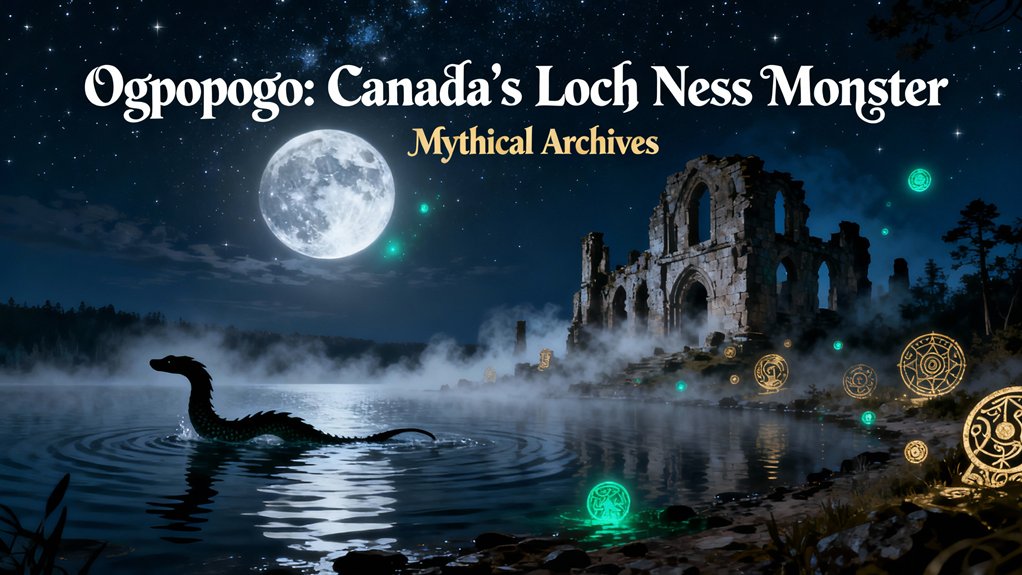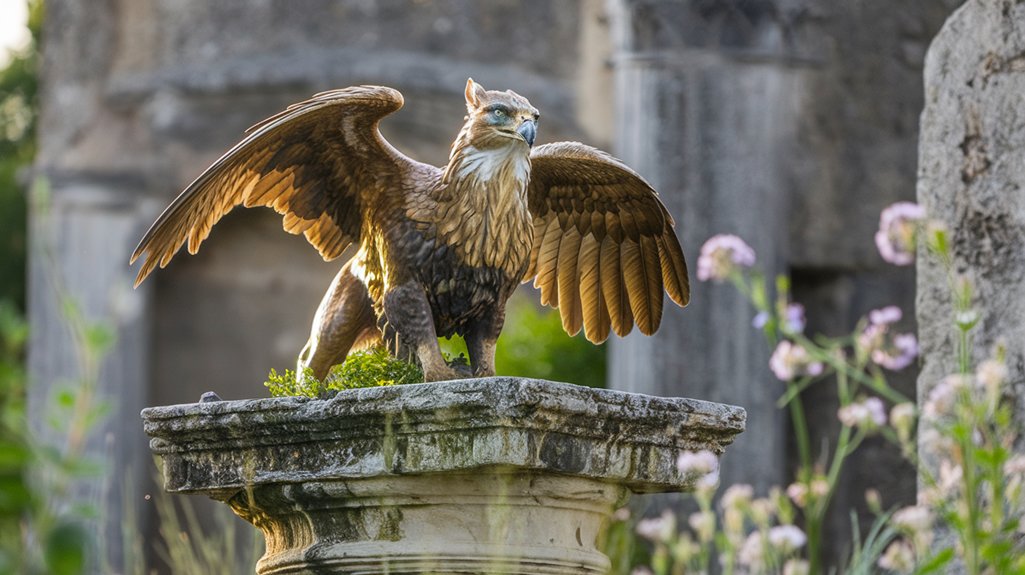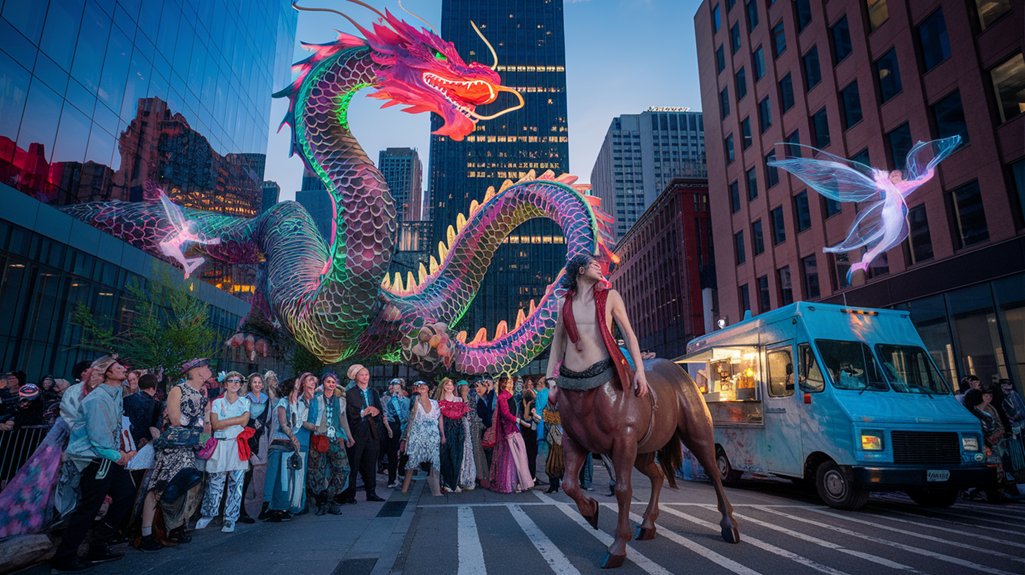You'll find Ogopogo—known to the Syilx people as N'ha-a-itk—inhabiting Okanagan Lake's abyssal depths since time immemorial, demanding offerings before safe passage. Since Susan Allison's 1872 encounter, hundreds have witnessed this serpentine entity: steamboat crews in 1914, thirty beachgoers in 1926, cinematographers capturing eldritch wakes in 1947 and 1968. Sonar echograms reveal massive biological signatures moving purposefully through glacial strata, though skeptics attribute sightings to sturgeons or wave patterns. This chimeric guardian has altered British Columbia's tourism industry while preserving Indigenous prophecy—ancient mysteries that await your deeper investigation.
Key Takeaways
- Ogopogo is a legendary lake creature inhabiting Okanagan Lake in British Columbia, Canada's answer to Scotland's Loch Ness Monster.
- The Syilx people revered N'ha-a-itk as a primordial guardian, making offerings before crossing the lake for centuries.
- Modern sightings began in 1872, with documented witness accounts, photographs, and sonar data accumulated through the 20th century.
- Scientists attribute sightings to wave patterns, swimming otters, sturgeon, or debris, though evidence remains inconclusive and ambiguous.
- Ogopogo drives significant tourism revenue, appearing on merchandise, attractions, and branding throughout British Columbia since 1926.
The Ancient Legend of N'ha-a-itk and Syilx Traditions
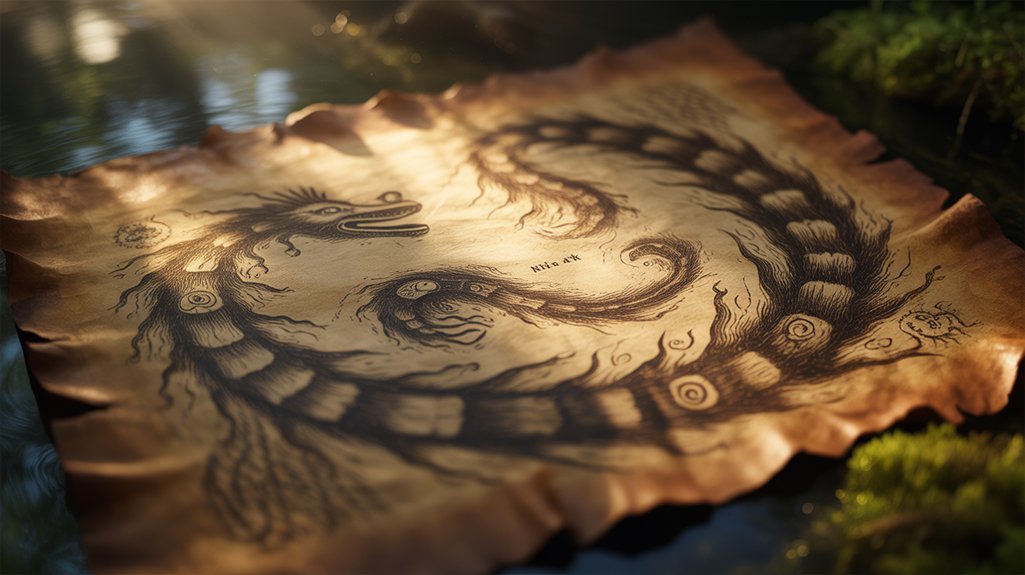
Long before European cartographers traced the sinuous form of Okanagan Lake onto their imperfect maps, the Syilx people—whose territories have encompassed these waters for millennia—spoke in hushed reverence of N'ha-a-itk, the lake's primordial guardian.
You'll find the n'ha a itk origins deeply rooted in spiritual cosmology, not mere folklore. This eldritch entity demanded respect, sacrifice, and acknowledgment from those who dared traverse its domain.
The syilx storytelling tradition preserves accounts of N'ha-a-itk's chimeric form—serpentine, powerful, sacred. Witnesses described undulating coils breaking glassy surfaces, creating waves that capsized canoes of the unprepared.
The Syilx understood something you're only beginning to grasp: this wasn't superstition. This was survival knowledge.
Before crossing, offerings were made. Small animals. Tobacco. Prayers.
The lake possessed teeth.
Those who ignored these protocols rarely returned, their absence explained by elders through cautionary tales that bound community members to protocols older than any colonial claim could ever supersede.
Historic Sightings and Eyewitness Testimonies Through the Decades
When Susan Allison documented her 1872 encounter on Okanagan Lake's western shore, the systematic cataloging of modern Ogopogo sightings began—though indigenous warnings had echoed across these waters for centuries before white settlers arrived with their notebooks and taxonomic presumptions.
You'll find the historical accounts intensifying through subsequent decades: steamboat crews reporting undulating coils breaking the surface in 1914, their testimonies corroborated by multiple passengers simultaneously witnessing the chimeric form.
The 1926 sighting at Mission Beach brought thirty witnesses together, their eyewitness narratives describing a serpentine creature estimated at forty feet. You can't dismiss such collective observation easily.
By mid-century, the accounts proliferated—1947 delivered photographs, grainy yet compelling. The 1968 Folden footage captured something eldritch moving through summer waters, defying conventional explanation.
Each decade layered new testimonies upon ancient certainties, creating an archive that demands attention from those who understand lakes keep secrets, releasing them only when they choose.
Physical Evidence: Photographs, Videos, and Sonar Data
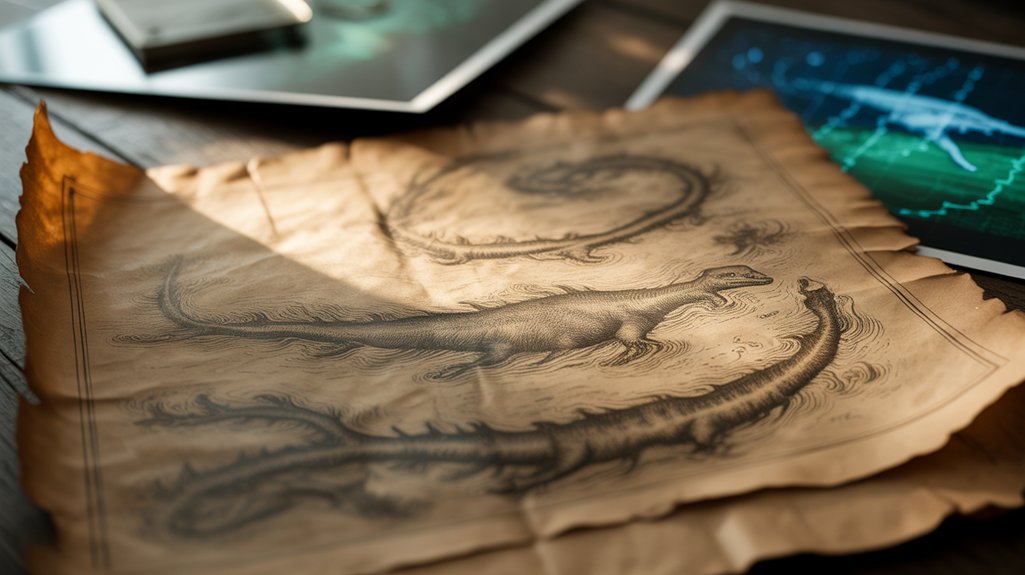
The photographic record begins properly in 1947 with Art Folden's 16mm film—thirty-five feet of celluloid capturing a v-shaped wake trailing something substantial, something animate, something that refused terrestrial categorization.
You'll find subsequent decades yielding increasingly sophisticated documentation: the 1968 Basil Harwood footage, the 1989 Ken Chaplin videotape, each frame subjected to rigorous photo analysis by researchers seeking verification beyond subjective testimony.
Sonar technology entered the investigation during the 1970s, when echograms detected massive subaquatic forms moving with deliberate, chimeric grace through Okanagan's thermocline layers.
Echograms revealed massive forms gliding through thermocline depths—biological signatures moving with purpose through Okanagan's darkest waters.
The 1984 expedition registered objects exceeding fifteen meters, biological signatures that defied conventional piscine explanation.
Yet none of this evidence achieves definitive resolution—each photograph remains tantalizingly ambiguous, each sonar ping suggests without confirming.
The creature preserves its eldritch mystery despite modernity's surveillance apparatus, as though such beings exist precisely in those liminal spaces our instruments can't fully penetrate, dwelling between empiricism and dream.
Scientific Theories and Skeptical Explanations
Scientific orthodoxy confronts such evidence with methodical incredulity, marshaling explanations that anchor the phenomenon firmly within known zoological parameters. You'll find scientific skepticism dissecting each encounter through biological plausibility's unforgiving lens.
| Phenomenon Observed | Skeptical Explanation | Supporting Evidence |
|---|---|---|
| Undulating humps | Wave patterns, floating logs | Meteorological studies, 1968-present |
| Serpentine movement | Otters swimming in sequence | Behavioral zoology documentation |
| Large dark shape | Sturgeon, submerged debris | Indigenous fish populations |
These prosaic interpretations clash against the eldritch testimony of witnesses who've gazed upon something chimeric, something that defies rational categorization. The scientific establishment acknowledges misidentification's power—how expectation alters ordinary aquatic life into legendary beasts. Yet dismissal doesn't extinguish the phenomenon's persistent cultural resonance. You're left traversing liminal territory where empirical methodology meets ancestral knowing, where the Syilx people's ancient n̓x̌ax̌aitkʷ remains irreducible to mere biological error, dwelling instead within memory's deeper waters.
Ogopogo's Cultural Impact on Canadian Tourism and Pop Culture
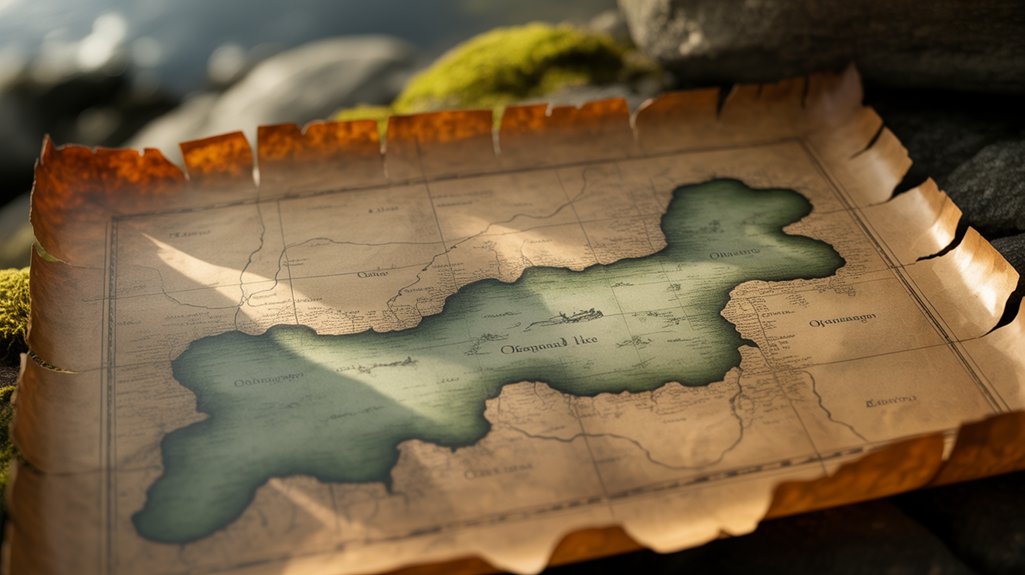
Since 1926, when British Columbia's tourism bureaus first weaponized the creature's mystique, Ogopogo has evolved beyond cryptozoological curiosity to become economic bedrock.
You'll find its chimeric form emblazoned across municipal signage, vineyard labels, marina facades—each iteration commercializing what the Syilx people considered sacred. The eldritch serpent now anchors Kelowna's tourist attractions, generating millions annually through themed boat tours, museum exhibitions, waterfront sculptures that domesticate the numinous.
Pop culture absorbed this commodification enthusiastically. The creature appears in Canadian television series, comic books, provincial license plates, converting ancient N'ha-a-itk into mascot.
Yet something persists beneath commercial veneer. Local businesses still invoke Ogopogo with reverential branding, acknowledging, perhaps unconsciously, that economic prosperity remains tethered to respecting what swims in those depths.
The tourism industry recognizes paradox: profit demands visibility while mystery requires concealment. You witness capitalism's strange covenant with the unknowable, where commerce and cosmology negotiate uneasy coexistence along Okanagan's shores.
Frequently Asked Questions
How Deep Is Okanagan Lake Where Ogopogo Is Said to Live?
You'll find Okanagan Lake plunges to depths of 761 feet—sufficiently abyssal to conceal chimeric entities within its cold, lightless waters.
The lake depth creates perfect conditions for cryptid concealment, those liminal zones where surface world meets submarine darkness.
Okanagan legends, preserved through generations of Syilx peoples, speak of N'ha-a-itk dwelling in these profound depths near Rattlesnake Island.
Ancient waters. Endless mystery. Here, freedom seekers discover that some territories remain forever beyond human dominion, eternally sovereign.
What Should I Do if I Spot Ogopogo While Boating?
Should you glimpse this eldritch entity's sinuous form breaching Okanagan's depths, maintain calm adherence to basic safety precautions: reduce speed, secure loose equipment, guarantee passengers don't lean overboard.
Follow established boating etiquette—don't pursue the creature aggressively or disturb its retreat. You're free to observe, photograph, document.
The N'ha-a-itk, as Syilx peoples knew it, deserves respectful distance. Report your encounter to local cryptozoological researchers.
Remember: you've witnessed something ancient, chimeric, profound—a manifestation existing beyond conventional taxonomy's rigid boundaries.
Are There Organized Ogopogo Hunting Expeditions or Research Trips Available?
You'll discover ogopogo tours operating from Kelowna's shores, where specialized monster expeditions blend cryptozoological inquiry with Indigenous N'ha-a-itk traditions.
Local outfitters navigate Okanagan's eldritch depths, offering freedom to explore chimeric mysteries without institutional constraints. These excursions honor Syilx sacred knowledge while employing sonar technology, creating liminal experiences between ancient reverence and modern investigation.
Summer months prove ideal. Dawn departures pierce morning fog, when witnesses throughout decades have glimpsed undulating forms beneath crystalline waters.
Has Anyone Ever Claimed to Catch or Harm Ogopogo?
You'll find no verified accounts of Ogopogo's capture or death in the historical record.
The indigenous Syilx people's ancient protocols explicitly forbade harming N'ha-a-itk, their sacred water serpent.
Modern Ogopogo sightings, spanning from the 1870s onward, consistently describe a creature that vanishes beneath Okanagan's depths before any confrontation occurs.
The Ogopogo legends themselves suggest an eldritch entity beyond mortal dominion—chimeric, untouchable, dwelling in those liminal spaces where your world meets the inexplicable deep.
What Is the Best Time of Year to See Ogopogo?
You'll find the best viewing times during summer's warmth, when waters calm and tourist vessels multiply, when ancient patterns resurface.
Seasonal patterns reveal Ogopogo's eldritch presence most frequently between May and September, particularly during dawn's liminal hours and dusk's fading light.
The creature's chimeric form emerges when Okanagan Lake's surface stills, reflecting sky and mountain.
Thermal shifts. Surface disturbances.
You're free to chase this mystery when conditions align—when scholarly observation meets the ineffable unknown beneath rippling depths.
Conclusion
You stand at the threshold between empirical certainty and eldritch possibility, much like the Syilx ancestors who first named N'ha-a-itk. This chimeric creature—whether corporeal beast or collective archetype—mirrors humanity's perpetual search for mystery in an over-examined world. You'll leave Okanagan's shores changed, carrying both skepticism and wonder. The water keeper's tale endures not despite modernity's reach, but because you still crave what science can't yet illuminate.
